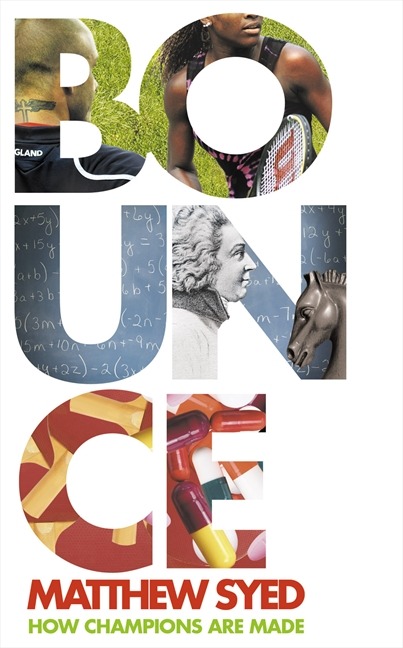Smashing little talent: a sporting story
One street spawns 12 table tennis stars? In an extract from his new book, former Olympian Matthew Syed asks how
In January 1995 I became the British No 1 table tennis player for the first time — which, I am sure you will agree, is a heck of an achievement. Table tennis is a pretty big sport in the UK, with 2.4 million participants, 30,000 paid-up members of the governing body, thousands of teams and serious riches for those who excel.
But what made me special? What had marked me out for greatness? I came up with various attributes: speed, guile, gutsiness, mental strength, adaptability, agility and reflexes. Sometimes I would marvel that I had these skills in such abundance that they were capable of elevating me — little me! — beyond hundreds of thousands of others aspiring to that precious top spot. And all this was doubly amazing, considering that I had been born into a family in an ordinary suburb of an ordinary town in southeast England. There was no silver spoon. No nepotism. Mine was a triumph of individuality, a personal odyssey of success, a triumph against the odds.
This, of course, is the way that many who have reached the top in sport, or indeed in any other field, choose to tell their stories. We live in a culture that encourages this kind of soaring individualism. But while these stories are inspirational, rousing and entertaining, are they true? Here is my table tennis story, retold with the bits that I chose to ignore the first time around, as they diminished the romance and individuality of my triumph.
1. Table In 1978 my parents, for reasons they are still unable to explain, decided to buy a table tennis table — a super deluxe 1000 with gold lettering, since you ask — and to put it in our large garage. You can imagine that there were not many youngsters of my age (I was 8 at the time) in my home town who possessed a full-size, tournament-specification table. Fewer still had a garage in which it could be housed full-time. This was my first bit of good fortune.
2. My Brother My second piece of good fortune was having an older brother, Andrew, who came to love table tennis as much as I did. We would play for hours after school: duelling, battling, testing each other’s reflexes, experimenting with new spins, investigating new paddles, inviting over friends who, although often more accomplished in other sports, were bemused to see just how far we had advanced in table tennis.
3. Peter Charters Mr Charters was a teacher at the local primary school, a tall man with a moustache, a twinkle in his eye and a disdain for conventional teaching methods. He was the coach of almost all the after-school sporting clubs, the organiser of school sports day and inventor of a game called “bucket ball”, a kind of improvised basketball.
But Charters cared about one thing above all: table tennis. He was the nation’s top coach and a senior figure in the English Table Tennis Association. No child who passed through Aldryngton School in Reading was not given a try-out by Charters — and such were his zeal, energy and dedication to table tennis that anybody who showed potential was persuaded to take his or her skills forward at the local club, Omega. He invited me and my brother to join Omega in 1980, just when we were beginning to outgrow the garage.
4. Omega Omega was not a luxurious club: it was a one-table hut in a gravel enclosure in suburban Reading: cold in winter, ferociously hot in summer, with plants growing through the roof and floor. But it had one advantage that made it almost unique in the county: it was open 24 hours a day for the exclusive use of its tiny group of members, each of whom had a set of keys.
My brother and I took full advantage, training after school, before school, at weekends and during school holidays. We were joined by other Aldryngton alumni who had been spotted and snapped up by Charters, so that by 1981 Omega was becoming something of a sensation. One street alone (Silverdale Road, where the school was) contained an astonishing number of the nation’s top players.
At No 119 were the Syeds. Andrew, my brother, went on to become one of the most successful junior players in the history of British table tennis, winning three national titles before retiring due to injury in 1986. Matthew (that’s me) also lived at 119 and became a long-serving England senior No 1, a three-time Commonwealth champion and a two-time Olympian.
At No 274, just opposite Aldryngton, lived Karen Witt. She went on to win the Commonwealth championships and was widely considered one of the most brilliant female players of her generation. At No 149, equidistant between the Syeds and the Witts, lived Andy Wellman. He was a top national player who won a string of titles, particularly in doubles.
Down at the bottom of Silverdale Road were Paul Trott, a leading junior, and Keith Hodder, an outstanding county player. Around the corner were Jimmy Stokes (England junior champion), Paul Savins (junior international), Alison Gordon (four times English senior champion), Paul Andrews (top national player) andSue Collier (England schools champion). I could go on.
For a period in the 1980s, this street and its immediate vicinity produced more outstanding table tennis players than the rest of the nation. One road among tens of thousands of roads; one tiny cohort of schoolkids against millions up and down the country. Silverdale Road was the wellspring of English table tennis: a ping-pong mecca that seemed to defy explanation or belief.
Had some genetic mutation spread through the area without touching the surrounding roads and villages? Of course not: the success of Silverdale Road was about the coming together of factors of a kind beguilingly similar to those that have, from time to time, elevated other tiny places into the sporting ascendancy (for example, Spartak, an impoverished Moscow tennis club, created more Top 20 women players between 2005 and 2007 than the whole of the US).
In our case, all the local sporting talent was focused ruthlessly on table tennis, and all the aspiring players were nurtured by an outstanding coach. As for me, with a table in the garage and a brother as passionate about the game as I was, I had a head start before I even went to Aldryngton .
We like to think that sport is a meritocracy in which achievement is driven by talent and hard work, but it is nothing of the sort. Think of the thousands of potential table tennis champions not fortunate enough to live in Silverdale Road, with its peculiar set of advantages. Think of the thousands of potential Wimbledon champions who have never been fortunate enough to own a tennis racket or to receive specialised coaching. Think of the millions of potential Major-winning golfers who have never had access to a golf club.
Practically every man or woman who triumphs against the odds is, on closer inspection, a beneficiary of unusual circumstances. The delusion lies in focusing on the individuality of their triumph without perceiving the powerful opportunities stacked in their favour.
This is one of the central points made by Malcolm Gladwell in his book Outliers. “The people who stand before kings may look like they did it all by themselves,” he writes, “but in fact they are invariably the beneficiaries of hidden advantages and extraordinary opportunities and cultural legacies that allow them to learn and work hard and make sense of the world in ways others cannot.”
Whenever I am inclined to think that I am unique and special, I remind myself that, had I lived one door farther down the road, I would have been in a different school catchment area, so I would not have attended Aldryngton, would never have met Peter Charters and would never have joined Omega. It is often said that in elite sport the margins of victory and defeat are measured in milliseconds: in reality they are measured in variables that are far more elusive.
It is worth pausing here to consider an objection. You may agree that opportunity is necessary for success, but is it sufficient? What about the natural gifts that mark out the very best from the rest? Are these innate skills not necessary to get to a Wimbledon final or the top of an Olympic podium? Are they not vital to becoming a chess grandmaster or the CEO of a multinational company?
This has been the abiding presumption of modern society ever since Francis Galton, Darwin’s half-cousin, published his bookHereditary Genius, in which he argued that “a man’s natural abilities are derived by inheritance, under exactly the same limitations as are the form and physical features of the whole organic world”.
But is talent what we think it is?
What is talent?
Most people feel sure that they know natural talent when they see it; that they can look at a group of kids and discern from the way they move, the way they interact, the way they adapt, which of them contain the hidden genes necessary for success. As the director of a prestigious violin school put it: “Talent is something a top violin coach can spot in young musicians that marks them out as destined for greatness”. But how does the teacher know that this accomplished young performer, who looks so gifted, has not had many hours of special training behind the scenes? How does he know that the initial differences in ability between this youngster and the rest will persist over years of practice? In fact, he doesn’t, as several studies have demonstrated.
A ground-breaking investigation of British musicians, for example, found that the top performers had learnt no faster than those who reached lower levels of attainment: hour for hour, the various groups had improved at almost identical rates. The difference was simply that top performers had practised for more hours. Further research has shown that when top performers seem to possess an early gift for music, it is often because they have been given extra tuition at home by their parents.
The same conclusion — about the primacy of practice and opportunity rather than talent — is reached by widening the perspective, as the psychologist Anders Ericsson has shown. Consider the way in which standards have risen dramatically in just about every area of human endeavour. Take music: when Franz Liszt composed Feux Follets in 1826, it was said to be virtually unplayable; today it is performed by every top pianist.
The same is true in sport. In diving, the double somersault was almost prohibited in the 1924 Olympics because it was considered dangerous; now it is routine. The fastest time for the marathon in the 1896 Olympics was just a few minutes faster than the entry time for the Boston Marathon today, which is achieved by thousands of amateur runners.
In academia, too, standards are spiralling ever upwards. The 13th-century English scholar Roger Bacon argued that it was impossible to master mathematics in less than 30 or 40 years; today calculus is taught to almost every college student. And so it goes on.
The key point is that these improvements have not occurred because people are getting more talented: Darwinian evolution operates over a much longer timespan. They must have occurred, therefore, because people are practising longer, harder (due to professionalism) and smarter. It is the quality and quantity of practice, not genes, that is driving progress.
And if that is true of society, why not accept that it is also true of individuals?
Bounce: How Champions Are Made, by Matthew Syed

 RAWFIT est. 1999
RAWFIT est. 1999 
